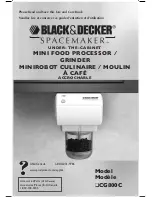MPC8360E/MPC8358E PowerQUICC II Pro Processor Revision 2.x TBGA Silicon Hardware Specifications, Rev. 4
102
Freescale Semiconductor
System Design Information
The Bergquist Company
800-347-4572
18930 West 78th St.
Chanhassen, MN 55317
Internet: www.bergquistcompany.com
23.3
Heat Sink Attachment
When attaching heat sinks to these devices, an interface material is required. The best method is to use
thermal grease and a spring clip. The spring clip should connect to the printed-circuit board, either to the
board itself, to hooks soldered to the board, or to a plastic stiffener. Avoid attachment forces which would
lift the edge of the package or peel the package from the board. Such peeling forces reduce the solder joint
lifetime of the package. Recommended maximum force on the top of the package is 10 lb force (4.5 kg
force). If an adhesive attachment is planned, the adhesive should be intended for attachment to painted or
plastic surfaces and its performance verified under the application requirements.
23.3.1
Experimental Determination of the Junction Temperature with a
Heat Sink
When heat sink is used, the junction temperature is determined from a thermocouple inserted at the
interface between the case of the package and the interface material. A clearance slot or hole is normally
required in the heat sink. Minimizing the size of the clearance is important to minimize the change in
thermal performance caused by removing part of the thermal interface to the heat sink. Because of the
experimental difficulties with this technique, many engineers measure the heat sink temperature and then
back calculate the case temperature using a separate measurement of the thermal resistance of the
interface. From this case temperature, the junction temperature is determined from the junction-to-case
thermal resistance.
T
J
= T
C
+ (R
θ
JC
×
P
D
)
where:
T
J
= junction temperature (
°
C)
T
C
= case temperature of the package (
°
C)
R
θ
JC
= junction to case thermal resistance (
°
C/W)
P
D
= power dissipation (W)
24 System Design Information
This section provides electrical and thermal design recommendations for successful application of the
MPC8360E/58E. Additional information can be found in MPC8360E/MPC8358E PowerQUICC Design
Checklist (AN3097).


















